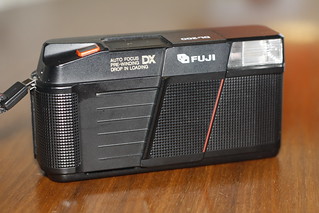Difference between revisions of "Fuji DL-200"
(→Specifications) |
m (Corrected heading) |
||
| (11 intermediate revisions by 4 users not shown) | |||
| Line 18: | Line 18: | ||
}} | }} | ||
</div> | </div> | ||
| − | The '''Fuji DL-200''', released in 1983 | + | The '''Fuji DL-200''', released in 1983. In Japan it is known as the '''Fuji Cardia'''. It was claimed in a 1986 advertisement to be the world's first drop-in loading [[autofocus]] [[compact camera]].<ref>Peter Justensen Duty-Free Catalogue, 1986 edition</ref> DL stands for "drop-in loading". There is a prewinding safety system: upon loading, film is wound to what on most cameras would be the last frame, which here is exposed first. This was the first Fuji camera with prewinding, and possibly a world first in 35 mm. |
The lens is a 32 mm f/2.8, focussing from 60 cm to infinity. Autofocus works even at night. | The lens is a 32 mm f/2.8, focussing from 60 cm to infinity. Autofocus works even at night. | ||
| Line 29: | Line 29: | ||
Power comes from some "built-in" batteries; the manual claims you need to send the camera back to a Fuji agent to have them replaced<ref>[http://www.cameramanuals.org/fuji_pdf/fujica_dl-200.pdf user manual] - provided by Mike Butkus</ref>, and that the batteries will last "1000 frames if 50% ... with flash", "5 years if 8 24-exposure films are used per year". | Power comes from some "built-in" batteries; the manual claims you need to send the camera back to a Fuji agent to have them replaced<ref>[http://www.cameramanuals.org/fuji_pdf/fujica_dl-200.pdf user manual] - provided by Mike Butkus</ref>, and that the batteries will last "1000 frames if 50% ... with flash", "5 years if 8 24-exposure films are used per year". | ||
| − | The DL-200 II revised this, making the battery user- | + | The '''DL-200 II''' (Cardia II) revised this, making the battery user-replaceable. It was also sold in red. |
| + | |||
| + | {{Flickr_image | ||
| + | |image_source= http://www.flickr.com/photos/lkafka/6354405099/in/pool-camerawiki/ | ||
| + | |image= http://farm7.staticflickr.com/6043/6354405099_a41d6b0660_n.jpg | ||
| + | |image_align= left | ||
| + | |image_text= | ||
| + | |image_by= Linus Kafka | ||
| + | |image_rights= with permission | ||
| + | }} | ||
<br clear=left /> | <br clear=left /> | ||
| Line 38: | Line 47: | ||
* Shutter: Programmed electronic, 1/40–1/400 s, self-timer. | * Shutter: Programmed electronic, 1/40–1/400 s, self-timer. | ||
* Metering: Through-the-lens off-the-film direct metering. | * Metering: Through-the-lens off-the-film direct metering. | ||
| − | * Film speed: | + | * Film speed: ISO 50–1600, set by [[DX code]]. Non-DX films exposed at ISO 100. |
| − | * Flash: Built-in, [[GN | + | * Flash: Built-in TTL flash, [[GN]] 10. Fill-in button on back, but no flash disable button. |
* Power: Built-in 6 V lithium battery. | * Power: Built-in 6 V lithium battery. | ||
* Dimensions: 134 x 69 x 42,5 mm. | * Dimensions: 134 x 69 x 42,5 mm. | ||
* Weight: 265 g. | * Weight: 265 g. | ||
| − | == | + | ==Notes== |
<references /> | <references /> | ||
==Links== | ==Links== | ||
| − | |||
* [http://www.cameramanuals.org/fuji_pdf/fujica_dl-200.pdf user manual] - provided by Mike Butkus. | * [http://www.cameramanuals.org/fuji_pdf/fujica_dl-200.pdf user manual] - provided by Mike Butkus. | ||
[[Category: Fuji|DL-200]] | [[Category: Fuji|DL-200]] | ||
| + | [[Category:D|DL-200 Fuji]] | ||
[[Category:Japanese 35mm autofocus]] | [[Category:Japanese 35mm autofocus]] | ||
[[Category:F]] | [[Category:F]] | ||
[[Category:1983]] | [[Category:1983]] | ||
[[Category:Prewind]] | [[Category:Prewind]] | ||
Latest revision as of 05:20, 1 March 2023

|
| Fuji DL-200 image by Bernard Faure (Image rights) |

|
| with teleconverter and supplied name tag image by AWCam (Image rights) |
The Fuji DL-200, released in 1983. In Japan it is known as the Fuji Cardia. It was claimed in a 1986 advertisement to be the world's first drop-in loading autofocus compact camera.[1] DL stands for "drop-in loading". There is a prewinding safety system: upon loading, film is wound to what on most cameras would be the last frame, which here is exposed first. This was the first Fuji camera with prewinding, and possibly a world first in 35 mm.
The lens is a 32 mm f/2.8, focussing from 60 cm to infinity. Autofocus works even at night. There was a teleconverter and a close-up attachment available.
Exposure is automatic, using a TTL system, working from EV8.5-18 with ISO 100 film, the film speed (50-1600 ISO) being set automatically by DX Coding. The Guide-Number 10 flash is automatic, set by the TTL exposure metering, but with a "fill-in flash" button on the back.
The camera weighs 280g.
Power comes from some "built-in" batteries; the manual claims you need to send the camera back to a Fuji agent to have them replaced[2], and that the batteries will last "1000 frames if 50% ... with flash", "5 years if 8 24-exposure films are used per year".
The DL-200 II (Cardia II) revised this, making the battery user-replaceable. It was also sold in red.

|
| image by Linus Kafka (Image rights) |
Specifications
- Lens: Fujinon 32 mm f/2,8 (4 elements/4 groups)
- Focusing: Autofocus with focus lock, 0,6 m to infinity.
- Shutter: Programmed electronic, 1/40–1/400 s, self-timer.
- Metering: Through-the-lens off-the-film direct metering.
- Film speed: ISO 50–1600, set by DX code. Non-DX films exposed at ISO 100.
- Flash: Built-in TTL flash, GN 10. Fill-in button on back, but no flash disable button.
- Power: Built-in 6 V lithium battery.
- Dimensions: 134 x 69 x 42,5 mm.
- Weight: 265 g.
Notes
- ↑ Peter Justensen Duty-Free Catalogue, 1986 edition
- ↑ user manual - provided by Mike Butkus
Links
- user manual - provided by Mike Butkus.